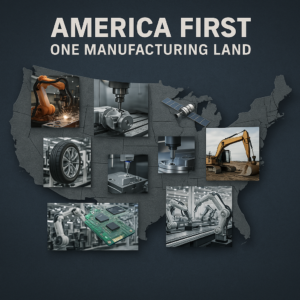“America First” in a Fragmented System: Why We Need to Build Together
“America First” is a powerful phrase—meant to inspire unity, strength, and national ambition. But beneath the surface, our economic development model tells a different story. Instead of a coordinated national strategy, we’ve built a fragmented system where regions compete against one another for the same jobs, funding, and innovation. What we face isn’t national progress—it’s regional isolation.
Across industries, companies are often restricted in where they can hire, expand, or collaborate. Venture-backed firms, for example, may be contractually bound to create jobs only in certain areas, with little flexibility to tap into talent or partnerships outside those boundaries. Sometimes, even working with an external supplier is discouraged or outright prohibited if they’re not locally based.
This isn’t just inefficient—it’s counterproductive. It limits innovation, inflates costs, and blocks the formation of the kind of regional-industrial ecosystems we need to grow critical sectors like aerospace, advanced manufacturing, and clean energy. Instead of collaborating across regions with complementary strengths, we end up duplicating efforts, siloing talent, and incentivizing short-term wins over long-term impact.
One recent example speaks volumes: a manufacturing company shuttered operations in one area and moved 150 jobs elsewhere. The decision was driven in part by lower wages and looser employment regulations. This wasn’t about growth—it was about shifting pieces on a national chessboard. A zero-sum gain for one region meant a real loss for another, with no net benefit to the country.
This is what happens when policy encourages local protectionism rather than national cooperation. We pit communities against each other, chasing headlines and headcounts, instead of building integrated, future-ready ecosystems. Other global regions are taking a different approach—encouraging cross-border collaboration, aligning regional investments with national goals, and funding industrial growth with shared purpose. We should be doing the same.
To be clear, regional pride and local investment matter. But they should be part of a broader, strategic framework—not substitutes for it. Companies need the freedom to grow where it makes sense. Talent should be able to contribute from wherever it resides. And innovation should be guided by opportunity and purpose, not policy constraints.
The current model promotes a type of zero-sum thinking that hurts the country’s long-term industrial health. While some regions secure temporary gains, the nation as a whole suffers from inefficiency and a lack of coordination. We need to shift our perspective—not just to grow faster, but to grow smarter.
Thankfully, there are signs of change. The current administration has begun laying the groundwork for a more unified, future-oriented industrial policy. Recent federal investments in infrastructure, clean energy, semiconductor manufacturing, and workforce development signal a clear shift in direction: toward national resilience, coordination, and long-term growth.
These initiatives are starting to unlock the potential for cross-regional cooperation. They’re encouraging the creation of advanced manufacturing hubs, workforce pipelines, and supply chain resilience programs that can operate across boundaries—not in spite of them.
But policy can only go so far.
It’s now on us—the industry, the builders, the entrepreneurs, the investors—to deliver.
We must think beyond borders. We must align around shared outcomes. And we must build the kind of resilient, interconnected, and dynamic industrial base that doesn’t just respond to global competition—but sets the standard for it.
“America First” can’t just be a slogan. It must become a strategy.
Not one rooted in fragmented efforts and regional isolation—but one built on shared ambition, smart cooperation, and collective action.
Let’s stop measuring success by how many jobs move from one community to another—and start measuring it by how many we create together.
The foundation is being laid. Now it’s time to build on it—together.


Recent Comments